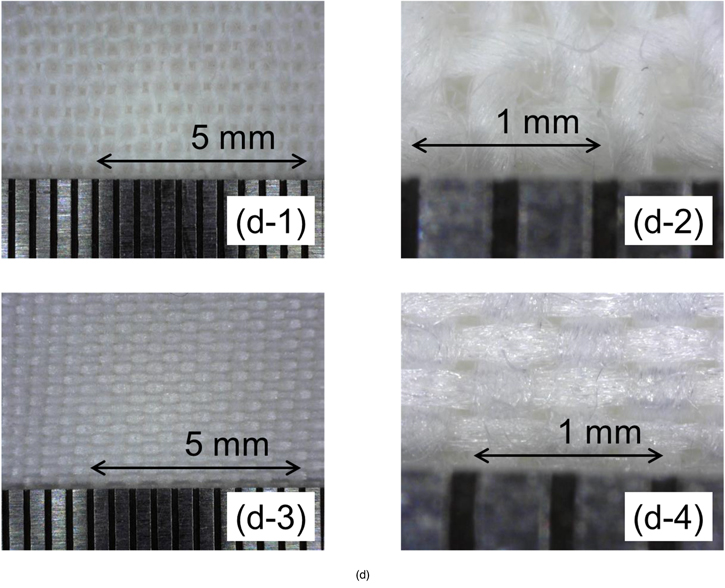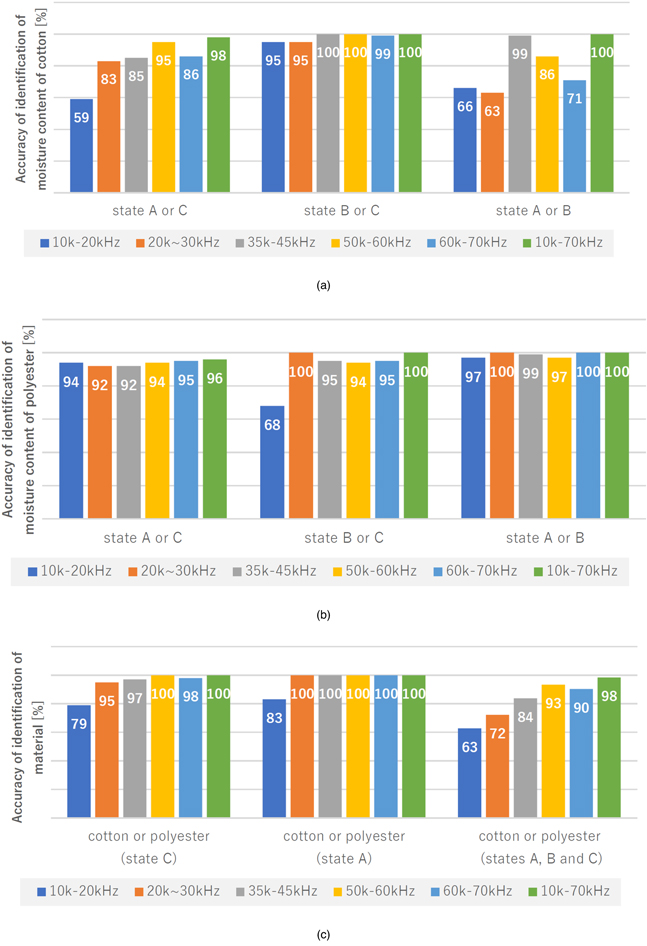Abstract
We fabricated a non-contact identification system employing multiple-frequency air ultrasonic transducers and a microphone capable of broadband measurement. This study aims to perform non-contact identification of the state of cloth using broadband acoustic analysis and machine learning. We conducted experiments to obtain basic data on the relationship between the moisture content of cloth and the frequency–amplitude characteristics. Using the proposed system, which combines high-resolution acoustic measurement and machine learning, we succeeded in noncontact identification of the moisture content of fabric. In addition, we verified the feasibility of this system in identifying whether the fabric material is cotton or polyester.
Export citation and abstract BibTeX RIS

Content from this work may be used under the terms of the Creative Commons Attribution 4.0 license. Any further distribution of this work must maintain attribution to the author(s) and the title of the work, journal citation and DOI.
In recent years, many types of pneumatic ultrasonic transducers have become readily available, 1–4) and they have been implemented in a variety of industrial product applications. 5–17) Engineering applications related to non-contact operation, 18–24) which utilize the characteristics of ultrasonic waves such as high directivity and resonance, are being actively studied. 25–33)
Our group has been conducting continuous research using ultrasonic transducers, including the development of acoustic sensing and acoustic levitation using air ultrasonic transducers. 6,7,21–23) The practical application of non-contact methods is one of the most critical areas of research today, owing to the current social problems such as the spread of infectious diseases. To date, several studies addressing non-contact measurement using ultrasound have been conducted. 34,35) Further, ultrasound measurement studies of the transmission characteristics of fabric materials have also been carried out. 36) However, although the acoustic properties of cloth have been discussed in previous studies, there has not yet been sufficient study of automatic identification using acoustic properties.
Previously, we had reported a robust classification system combining high-resolution acoustic measurement and machine learning. 37) This study demonstrates the high affinity between broadband acoustic measurement and machine learning.
In our previous study, 23) we fabricated a transmitting/receiving system using multi-frequency ultrasonic transducers and then conducted experiments to obtain basic data. In this study, we re-fabricated and improved a non-contact identification system employing multiple-frequency air ultrasonic transducers and a microphone capable of broadband measurement. Moreover, by combining the analysis of the broadband acoustic data acquired by this system with machine learning, object feature identification is performed. In addition, we investigate the effect of moisture content of cloth on the acoustic characteristics and show that the proposed system enables non-contact identification of the moisture content of cloth as well as the cloth material.
The novelty of this research is as follows: first, it uses broadband acoustic characteristics attained using multiple-frequency air ultrasonic transducers, and second, it automates the identification process through the application of machine learning. The goal of the system proposed in this paper is the automatic determination of the moisture content of a target object in a non-contact manner. For the future, we are considering the possibility of the automatic non-contact identification of objects; for example, we could check the safety of objects containing hazardous materials through non-contact means.
Figure 1(a) shows the prototype of the transmitting and receiving system with multiple-frequency air ultrasonic transducers, which was used in this experiment. This prototype system utilizes four transducers; two UT1612MPRs (resonant frequency: 40 ± 1 kHz) and two 250ST160s (resonant frequency: 25 ± 1 kHz) were placed crosswise to each other. A chirp signal from 10 kHz to 70 kHz was used as the sound source. Figure 1(b) shows the frequency–amplitude characteristics when the transducers were driven by the chirp signal. The red, blue, and black lines represent the results of driving the 250ST160, UT1612MPR, and all transducers, respectively. Combining the two types of transducers allowed us to obtain a broadband incident signal.
Download figure:
Standard image High-resolution imageFig. 1. (Color online) (a) Prototype of transmitting and receiving system. (b) Frequency–amplitude characteristics of transducers (c) system flow chart for object identification. (d) High-magnification photographs of the cotton (d-1 and d-2) and polyester (d-3 and d-4) cloth.
Download figure:
Standard image High-resolution imageFigure 1(c) shows the system flowchart used for identification. The following are important aspects of this system:
- 1.Multiple-frequency air ultrasonic transducers are employed to obtain broadband incident acoustic signals.
- 2.A microphone (4939, BK) with a frequency response of 4 Hz–100 kHz and a 768 kHz/32 bit high-resolution measurement system is used as the recording equipment to receive broadband acoustic signals.
- 3.The acoustic features are obtained by calculating the band-limited power in the frequency domain.
- 4.
Next, we present the results of our experiments. We investigated the effect of moistening on the frequency–amplitude characteristics. In this experiment, the targets included two kinds of cloth: polyester and cotton.
The cloth used in this experiment was an easily obtained mass-produced product. The materials used were as follows: cotton—dry weight of 21.65 g, measuring 45 cm × 45 cm (=10.7 mg cm−2); polyester—dry weight of 31.48 g, measuring 60 cm × 60 cm (=8.7 mg cm−2). Figure 1(d) shows the high-magnification photographs of the cotton (d-1 and d-2) and polyester (d-3 and d-4) cloth, where the ruler scale in the photos is 0.5 mm.
Each piece of cloth was moistened without dripping by controlling the amount of water, so that no water dripped from it. This was defined as state A: A fine-meshed polyester fabric can contain an average of 29.0 g (27.2–30.4 g) of water without dripping, while a fine-meshed cotton fabric can contain an average of 28.7 g (27.5–30.6 g) of water without dripping. These correspond to a dry basis moisture content of 92.1% and 132.6%, respectively. In addition, approximately half the water content is defined as state B: a fine-meshed polyester fabric can contain an average of 14.9 g (12.7–16.1 g), while a fine-meshed cotton fabric can contain an average of 13.9 g (10.9–15.6 g). These correspond to a dry basis moisture content of 47.2% and 64.24%, respectively. The dry fabric is defined as state C.
A target was inserted between the microphone and the transducers in the system, as shown in figure 1(a). The position and orientation of the target cloth are randomly set. The cloth is hung on a metal frame and fix the upper parts without tension. Figure 2(a) shows the frequency–amplitude response when a moistened fine-meshed cotton cloth was used as the target. In this figure, the result for a dry object is also depicted for comparison. Figure 2(a) shows that a large decrease in amplitude occurs over a wide frequency range due to the effect of moistening. From another viewpoint, this moistened polyester cloth would have good sound insulation performance over a wide ultrasonic frequency range.
Fig. 2. (Color online) Frequency–amplitude characteristics. (a) Frequency–amplitude characteristics of a fine-meshed cotton cloth. (b) Frequency–amplitude characteristics of a fine-meshed polyester cloth.
Download figure:
Standard image High-resolution imageFigure 2(b) shows the frequency–amplitude response when a moistened fine-meshed polyester cloth was used as the target. From the figure, it can be seen that the amplitude decreases over a wide frequency range owing to the effect of moistening. However, the effect of moistening was smaller in the case of cotton cloth compared to that of polyester.
Next, we investigated object identification based on the analysis of broadband acoustic signals using machine learning. Figure 1(c) shows the flow chart from the transmitting stage to the identification stage.
We calculated feature extraction based on band-limited power after envelope calculation and used the SVM algorithm for machine learning. Here, the dimension of the attribute vector was assumed to be 200. We verified the accuracy of identification by tuning parameters such as the frequency band and bandwidth.
Figure 3 shows the accuracy of the identification using the SVM model. The identification of the moisture content of cotton using broadband acoustic characteristics was found to be more accurate [Fig. 3(a)]. The accuracy with which the moisture content of polyester could be identified was also more accurate [Fig. 3(b)]. In contrast, for each cloth, the accuracy of identification using the narrow-band acoustic characteristics was sometimes approximately 60%–90%.
Fig. 3. (Color online) Accuracy of identifying the moisture content of cloth and cloth material. (a) Identification of moisture content of cotton (state A, B or C) (b) identification of moisture content of polyester (state A, B or C) (c) identification of cloth material (cotton or polyester).
Download figure:
Standard image High-resolution imageIn addition, we evaluated the SVM model with regard to the identification of cloth material. As shown in Fig. 3(c), the accuracy of identification of cotton or polyester was also highly accurate. The results suggest that it is possible to identify the moisture content or cloth type based on the analysis of broadband acoustic signals using machine learning. The results reveal the feasibility of a robust classification system that combines multiple-frequency air ultrasonic transducers and broadband acoustic measurements with machine learning.
For the frequency–amplitude characteristics obtained in this experiment, the moisture content was found to be proportional to the amplitude attenuation. These trends also can be clearly observed over a wide bandwidth. We believe that these trends may contribute to the improvement of the identification accuracy.
In this study, we fabricated a transmitting and receiving system using multiple-frequency ultrasonic transducers and conducted experiments to obtain basic data. We demonstrated the feasibility of the proposed system for non-contact identification of the moisture content of fabric and fabric material. It was clarified that the multiple-frequency air ultrasonic transducers are promising for the active measurement of broadband acoustic signals for machine learning analysis. In addition, it was found that the sound insulation characteristics of a cloth material can be modified by controlling the moisture content.





